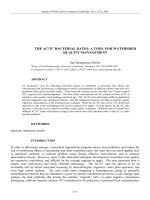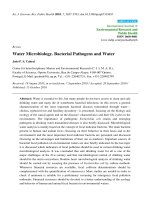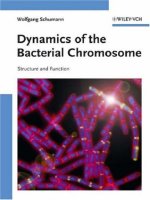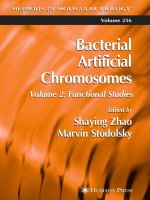Bacterial Spores (endospore)
Bạn đang xem bản rút gọn của tài liệu. Xem và tải ngay bản đầy đủ của tài liệu tại đây (4.55 MB, 34 trang )
Bacterial Spores (endospore)
Endospores form within the Cell
• Endospore is dormant stage of some
bacterium that allows it to survive
unfavorable conditions that would normally
be lethal such as extreme drought or heat
• Endospores are resistant against;
• Drought
• Low nutrient conditions
• Radiation
• High temperatures
• Various chemical disinfectants
FE206 Food Microbiology I
2
Endospores
The spore is a dehydrated, multishelled
structure that protects and allows the
bacteria to exist in “suspended animation”
It contains a complete copy of the
chromosome, the bare minimum
concentrations of essential proteins and
ribosomes, and a high concentration of
calcium bound to dipicolinic acid.
FE206 Food Microbiology I
3
The Vegetative Cell Gives Rise to One Spore
Bacterial Cell
Spore
Bacterial Cell
The endospore is able to survive for long periods
of time until environmental conditions again become favorable for growth.
The endospore then germinates, producing a single vegetative bacterium.
FE206 Food Microbiology I
4
Endospore Function
Endospores are ultimately protection for
the bacterial genome
Spores form within the cell and contain a
full copy of the bacterial genome
Endospores are not a form of reproduction,
because only one new cell germinates from
each spore
Spores can be variable in size and location
within the cell
FE206 Food Microbiology I
5
Sporulation or Sporogenesis
Process of
endospore
formation
within a
vegetative
(parent) cell
Germination =
return of an
endospore to its
vegetative state
FE206 Food Microbiology I
6
Sporulation
The sporulation process begins when
nutritional conditions become
unfavorable, depletion of the nitrogen or
carbon source (or both) being the most
significant factor.
Sporulation occurs massively in cultures
that have terminated exponential
growth as a result of such depletion.
FE206 Food Microbiology I
7
Sporulation involves the production of many new
structures, enzymes, and metabolites along with
the disappearance of many vegetative cell
components.
These changes represent a true process of
differentiation. A set of genes whose products
determine the formation and final composition of
the spore are activated, while another subset of
genes involved in vegetative cell function are
inactivated.
These changes involve alterations in the
transcriptional specifity of RNA polymerase, which is
determined by the association of the polymerase
core protein with one or another promoter-specific
FE206 Food Microbiology I
8
Sporulation
Morphologically, sporulation begins with the
isolation of a terminal nucleus by the inward
growth of the cell membrane.
The growth process involves an infolding of
the membrane so as to produce a double
membrane structure whose facing surfaces
correspond to the cell wall-synthesizing
surface of the cell envelope. The growing
points move progressively toward the pole
of the cell so as to engulf the developing
spore.
FE206 Food Microbiology I
9
Sporulation
The two spore membranes now engage in the
activity synthesis of special layer that will form
the cell envelope:
the spore wall and cortex, lying between the
facing membranes, and the coat and
exosporium lying outside the facing
membrane.
In the newly isolated cytoplasm, or core, many
vegetative cell enzymes are degraded and are
replaced by a set of unique spore constituents.
/>FE206 Food Microbiology I
10
Differences between Endospores and
Vegetative Cells
FE206 Food Microbiology I
11
Not all bacterial species can form spores
A few genera of bacteria produce
endospore such as Clostridium (gangrene)
and Bacillus (anthrax), both of them are
gram + rods
Endospore production is associated with
Gram Positive bacteria
Since not all bacteria form endospores, we
can use this as an identification factor
FE206 Food Microbiology I
12
The shape of the spore is an identifying
characteristic
Swelled vs. Not swelled
spore
spore
Bacterial cell
Bacterial cell
FE206 Food Microbiology I
13
The location of the spore is also an
identifying characteristic
Central, Sub-Terminal, and Terminal spores
FE206 Food Microbiology I
14
Endospores
Endospores can remain dormant
indefinitely but germinate quickly when
the appropriate trigger is applied
Endospores differ significantly from the
vegetative, or normally functioning, cells
FE206 Food Microbiology I
15
Some spore forming bacteria are capable of
causing disease
Clostridium botulinum – botulism
Clostridium perfingens – gas gangrene
Clostridium tetani – tetanus
Bacillus anthracis – Woolsorter’s Disease and
wound infections
The Schaeffer-Fulton Stain Procedure is
used to differentiate between endospores
and vegetative cells
FE206 Food Microbiology I
16
Schaeffer-Fulton Stain Procedure
1. Make a smear. Air Dry. Heat fix
2. Flood the smear with Malachite Green
stain
3. Cover the flooded smear with a square of
filter paper
4. Steam slide for 10 minutes (every minute,
add a few more drops of Malachite Green
stain)
5. Allow slide to cool (after the 10 min.
steam process)
FE206 Food Microbiology I
17
Schaeffer-Fulton Stain Procedure (cont’d)
6. Drain slide and rinse for 30 seconds with DI
water (discard filter paper)
7. Put slide on steam rack
8. Flood smear with Safranin (counter stain).
This stains the vegetative cell.
(Leave for 1 minute)
9. Drain the slide and rinse with DI water
10. Blot Dry
11. Use oil immersion objective to view
FE206 Food Microbiology I
18
Endospore Stain Example
Spores: Green
Cell: Red or Pink
FE206 Food Microbiology I
19
FE206 Food Microbiology I
20
Spore Germination
Activation by heat and nutrients
Ca-dipicolinate and cortex components
disappear
SASPs degrade
Swelling with H2O
Cell begins to divide like normal
Bacillus anthracis (and Clostridium)
produces endospores
Easily aerosolized and spread
Relatively easy and inexpensive to prepare in
laboratory
Can be easily transported without detection
FE206 Food Microbiology I
21
Tyndallization
by John Tyndall (1820-1893)
Boil for 15 min
Keep in warm, humid environment for 1 d
Boil for 15 min
Keep in warm, humid environment for 1 d
Boil for 15 min
FE206 Food Microbiology I
22
Properties
of
endospores
FE206 Food Microbiology I
23
Core
The core is the spore protoplast.
It contains a complete nucleus (chromosome),
all of the components of the proteinssynthetizing apparatus, and an energygenerating system based on glycolysis.
Cytochromes are lacking even in aerobic
species, the spores of which rely on shorted
electron transport pathway involving
flavoproteins. A number of vegetative cell
enzymes are increased in amount (eg. alanine
racemase), and a number of unique enzymes are
formed (eg. dipicolinic acid synthetase).
The energy for germination is stored as
3-phosphoglycerate rather than as ATP.
FE206 Food Microbiology I
24
Core
The heat resistance of spores is due in part to
their dehydrated state and in part to the
presence in the core of large amounts (5 – 15%
of the spore dry weight) of calcium
dipicolinate, which is formed from an
intermediate of the the lysine biosynthetic
pathway.
In some way not yet understood, these
properties result in the stabilization of the
spore enzymes, most of which exhibit normal
heat lability when isolated soluble form.
FE206 Food Microbiology I
25









